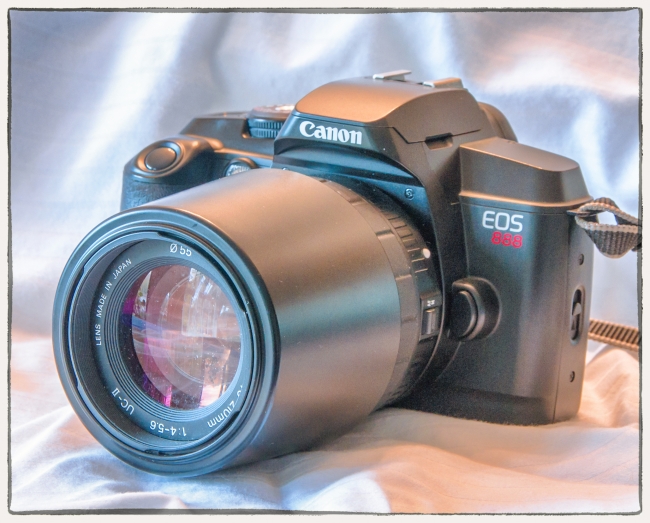This camera was given to me by an good friend. He’s not all that much into photography and I imagine that if he wanted to take pictures, he would be unlikely to ever use a 1995 vintage film camera. In fact the camera is in such great condition that it looks as if it’s rarely been used at all. If he’d ever used it it would probably have been perfect for him: an easy to use camera aimed at entry level users. It is the kind of camera to bring along to family occasions, use while travelling etc. when you want to capture some pleasant memories without breaking the bank.
It’s a Canon EOS 888 (also called EOS 5000) in some markets.
The bulk of its functionality is controlled by a large dial on top of the camera. It uses 6-zone evaluative metering (or 9.5% partial metering at the centre) linked to the focus points, as is the three zone flash metering.
The camera has fully automatic exposure control, with no manual option.It also has shutter priority automatic exposure, where you set a shutter speed and the camera selects an appropriate aperture. Shutter speeds from 1/8 sec to 1/2000 appear on the selector dial, but in full auto mode the shutter can go down to a full 2 seconds.
It’s quite small and lighter than most SLRs. Clearly a lot of plastic was used in its construction, but it still feels quite solid.
If you don’t want to use the fully auto mode, or the shutter priority AE you can simply select one of the four Program Image Control (PIC) modes: Portrait, Landscape, Close-up or Sports. Like the fully auto mode these modes control both the shutter speed and the aperture.
Advanced Integrated Multipoint (AIM) control allows the camera to adjust to meet the photographers intentions. For example, if your subject is to the left of the picture, the focusing sensor on the left will be used. This will activate the exposure sensors on the left of the camera, so that the light reading is also taken from this area, rather than from the centre.
The built in flash uses through the lens (TTL, ISO guide number of 12m at ISO 100) metering linked to the selected focus point.
The viewfinder has indicators for partial metering (AE lock); correct exposure (blinks when exposure is bad); and correct focus. The top panel LCD displays the number of frames remaining; self-timer seconds remaining; and the aperture when in shutter priority mode. There’s also a battery level indicator. The camera takes two CR123A Lithium batteries.
The camera features the typical Canon quick load capability. Just pull out the film leader to the clearly marked point, close the back and the camera automatically advances the film. I was surprised to find, however, that the camera advances to the end of the roll, and then counts down as you shoot. ISO is set automatically (i.e. no option to change it manually) from ISO15 to an ISO of 2000.
A quartz date model was also available. However, it’s only programmed to 2019.
The camera came with a Sigma 70-210mm f4-5.6 UC-II.
For results see Canon EOS 888 results.

